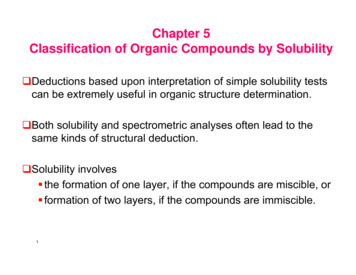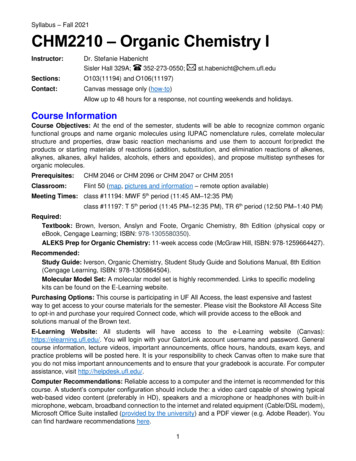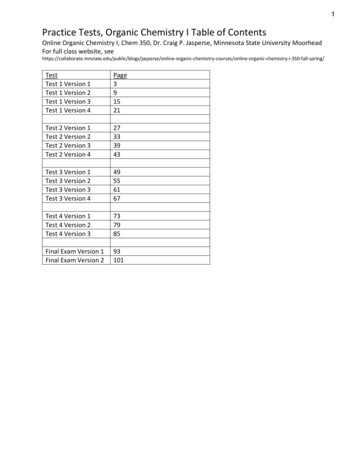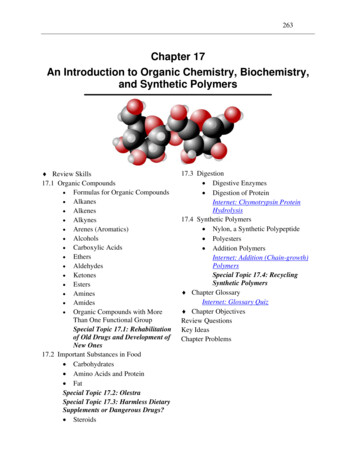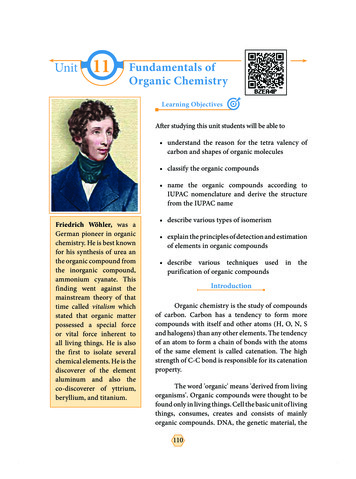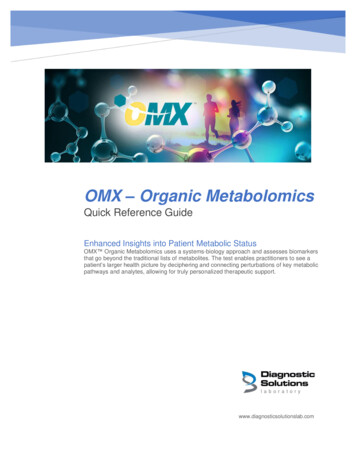
Transcription
OMX – Organic MetabolomicsQuick Reference GuideEnhanced Insights into Patient Metabolic StatusOMX Organic Metabolomics uses a systems-biology approach and assesses biomarkersthat go beyond the traditional lists of metabolites. The test enables practitioners to see apatient’s larger health picture by deciphering and connecting perturbations of key metabolicpathways and analytes, allowing for truly personalized therapeutic support.Diagnostic Solution Laboratorywww.diagnosticsolutionslab.com
1What is Metabolomics Testing?Metabolomics evaluates patterns of metabolites related to core biological systems,offering insight into baseline status and identification of biochemical dysfunctions thatcould be of concern.The test includes organic acids, amino acids, and other small molecules. The markersidentify levels of substrates and flow of pathways, which together help establish functionalstatus in six key areas of health. These areas are Metabolic Processing, Amino Acid andProtein Metabolism, Nutrition, Stress & Mood, Toxic Impacts, and Microbial Metabolism.Metabolites are impacted by many factors such as diet, nutrient status, genetics, gutmicrobiome, exercise, physiologic demands, immune reactions, and state of disease.
2Table of Contents1 – METABOLIC PROCESSING:3Glycolysis .3Krebs Cycle .3Fatty Acids and Beta-Oxidation.4Ketones .52 – AMINO ACID & PROTEIN METABOLISM:6Phenylalanine Metabolism .6Branched-Chain Amino Acid Metabolism (BCAA).7Tryptophan Metabolism .7Kynurenine/Tryptophan Ratio (KTR).8Quinolinic Acid / Kynurenic Acid Ratio (QKR) .9Methionine Metabolism .9Glutathione Markers .10Histidine Metabolism .11Threonine Metabolism .11Lysine Metabolism .12Glutamate & Aspartate Metabolism .12Collagen Catabolism .133 – NUTRITION:14B-Vitamin Complex (B1, B2, B3, B5, Lipoic Acid) .14Vitamin B-12 .14Folate .14Vitamin B-6 .14Biotin .14Plant Components .14Meat Intake .15Sugar Intake .154 – STRESS & MOOD:16Neurotransmitter .16Catecholamine Turnover .16Serotonin Turnover.16Steroid Hormone .165 – TOXIC IMPACTS:17Oxidative Damage .17Toxins .17Urea Cycle .17Kidney Impacts .186 – MICROBIAL METABOLITES:20Amino Acid Microbial Metabolites .20Polyphenol Microbial Metabolites .20Isoflavone Microbial Metabolites.21Fungal Assessment .21Key References:22
31 – METABOLIC PROCESSING:The breakdown products of macronutrients are funneled into the Krebs cycle.GlycolysisThe final product of glycolysis, the breakdown of glucose, is pyruvic acid in aerobic settings and lactic acid in anaerobic conditions.Carbohydrates – via glycolysis glucose pyruvic acid acetyl-CoAGlucose Glucose identifies processing of overall diet. Small amounts of glucose may befound in the urine of healthy individuals.o Elevated urinary glucose levels should be investigated further. Researchers found that those with a high waist-to-hip ratio (WHR), but nohistory of diabetes, had significantly lower urine glucose excretion. Metabolism of glucose – glycolysis – is heavily dependent on magnesium.Pyruvic Acid (Pyruvate) Increased pyruvic acid has been associated with increased glucose uptake. Increased pyruvic acid may indicate an insufficiency of nutrient cofactors (B1,B2, B3, B5, Lipoic Acid), resulting in upstream accumulation. Impaired pyruvate enzymes are associated with metabolic conditions, such asinsulin resistance, obesity, and type 2 diabetes mellitus. Pyruvic acid may be increased for 2–4 hours after continuous or high-intensityinterval exercise. When amino acids are used for energy in the muscle, pyruvic acid is used asan amino group acceptor (via alanine transaminase) and becomes alanine,which goes to the liver where pyruvic acid is turned into glucose(gluconeogenesis), and the nitrogen enters the urea cycle.Lactic Acid (Lactate) Lactic acid is produced endogenously under anaerobic conditions. The main route of lactic acid disposal is conversion to pyruvic acid or excretionvia urine. Higher urine lactic acid levels have been associated with diabetes, fastingglucose, HOMA-IR, Irritable Bowel Syndrome (IBD), chronic kidney disease,Fanconi syndrome, and age-related macular degeneration. Nutrient deficiencies of B1, CoQ10, and/or lipoic acid have been associatedwith elevated lactic acid levels in both urine and blood.Alanine In a review of baseline urine markers and conventional metabolicassessments, with a 5-year follow-up, elevated baseline urine alanine wasfound to correlate with elevated levels of A1C (effect size .8) and insulinresistance, independent of weight. Branched-chain amino acids (BCAA) are the primary nitrogen source forglutamine and alanine synthesis; BCAA are associated with metabolic disease.Krebs CycleCarbohydrates (from glycolysis), fats (from beta-oxidation,) and protein (via amino acids) all enter the Krebs cycle to generateenergy (ATP).Citric Acid (Citrate) Diet has a significant impact on citric acid levels:o Increased acid load due to diets high in animal-based proteins and insevere carbohydrate restriction can lead to mild metabolic acidosis,hypercalciuria, and reduced citric-acid excretion. Low urine citric acid has been associated with insulin resistance, metabolicacidosis, hypokalemia, the development of kidney stones, kidney disease andchronic kidney disease, and immune-mediated inflammatory diseases,including rheumatoid arthritis, psoriasis, psoriatic arthritis, systemic lupuserythematosus, Crohn’s disease, and ulcerative colitis. Alkalinization of urine through consumption of citrus foods, alkaline mineralwater, fruits and vegetables, or citrate supplements increases citric acid levels.Plant-based diets are associated with increased citric acid.cis-Aconitic AcidIsocitric Acid Cis-aconitic acid, along with ketones and suberic acid, were elevated inschizophrenia patients, compared to controls. In chronic kidney disease, urinary excretion of cis-aconitic acid and isocitricacid was reduced by 40–60%.
4 -Ketoglutaric Acid(Alpha-Ketoglutarate or AKG) Check levels and intake of amino acids that flow into the Krebs cycle at AKG:arginine, histidine, and glutamine. Insufficient B-complex vitamins, lipoic acid, and magnesium can lead toelevations of -ketoglutaric acid. Higher -ketoglutaric acid levels are seen in B1 deficiency; α-ketoglutaratedehydrogenase, as well as pyruvate and branched-chain ketoaciddehydrogenases, may all be impacted. Reduced in chronic kidney disease by 40–68%.Succinic Acid (Succinate) Check levels and intake of amino acids that flow into the Krebs cycle atsuccinyl CoA: valine, isoleucine, methionine, and threonine. Insufficient nutrients B2, B6, CoQ10, and magnesium could lead to elevationsof succinic acid; antioxidants may lower levels In a review of irritable bowel disease, both ulcerative colitis and Crohn’sdisease patients had low urine succinic acid. In chronic kidney disease, succinic acid was reduced by 40–68%.Fumaric Acid (Fumarate) Check levels and intake of amino acids that flow into the Krebs cycle: tyrosineand phenylalanine. Evaluate B-complex status. In chronic kidney disease in those with type 2 diabetes, urinary fumaric acidand malic acid predicted progression of disease.Malic Acid (Malate) Evaluate dietary sources of malic acid. It is the primary acid in apricot, blackand blue berries, cherries, grapes, peaches, pears, and plums. Some winesalso contain malic acid. Evaluate B-complex status.Fatty Acids and Beta-OxidationFatty acids undergo beta-oxidation via acyl-CoA dehydrogenase to enter the Krebs cycle to be used as energy. B2 is a cofactor.Fats – via beta-oxidation in 2C cycles fatty acids acetyl-CoADicarboxylic acids can result from ω-oxidationDicarboxylic Acids: Adipic Acid (C6) Pimelic Acid (C7) Suberic Acid (C8) Sebacic Acid (C10) Hepatic ω-oxidation is generally a minor fatty acid pathway, though it canincrease in diabetes, starvation, genetic fatty acid oxidation disorders, chronicalcohol consumption, and consumption of medium-chain triglycerides. People with metabolic syndrome or diabetes had significantly elevated adipicacid, suberic acid, lactic acid, and fumaric acid. Ketosis is sometimes accompanied by excessive excretion of adipic andsuberic acid. Lower C7 (pimelic acid) and C8 (suberic acid) and higher C4 (succinic acid)and C5 (glutaric acid) were associated with more efficient energy balance andbetter oxidative stress handling in Alzheimer’s disease research.o Suberic acid was elevated in schizophrenia patients. Acyl-CoA dehydrogenation enzymes are dependent on riboflavin (B2). Evaluate for high-adipate foods: beets, sugar cane, baked items, jams, jellies.Medium-Chain Acylglycines: Hexanoylglycine (C6) Suberylglycine (C10) 3-Phenylpropionylglycine (C11) Hexanoylglycine (C6), suberylglycine (C10,) and 3-phenylpropionylglycine(C11) are generally minor metabolites of fatty acid metabolism. Medium-chain acyl-CoA dehydrogenase deficiency (MCAD) is the mostcommon fatty-acid beta-oxidation disorder, with an elevation in hexanoylglycine, proprionoglycine, and suberylglycine, occurring in 1:20,000 in theNorthern European Caucasian population. Acyl-CoA dehydrogenation enzymes are dependent on riboflavin (B2);consider supplementation of B2, as well as B6, magnesium, and carnitine.Branched-Chain, Dicarboxylic Acids: Ethylmalonic Acid (C5) Methylsuccinic Acid (C5) A deficiency of short-chain acyl-CoA dehydrogenase (SCAD) can result inincreased excretion of ethylmalonic acid, methylsuccinic acid, or butyric acid.SCAD deficiency is often asymptomatic, except in times of stress. If treatmentis indicated, a diet high in carbohydrates and low in fat (primarily low inmedium-chain triglycerides) and carnitine supplementation may be considered. Women with gestational diabetes had higher levels of pyruvic and ethylmalonicacids (and lower levels of adipic acid). Acyl-CoA dehydrogenation enzymes are dependent on riboflavin. Considersupplementation of B2, as well as B6, magnesium, and carnitine. Riboflavin(B2) has been shown to be effective for decreasing ethylmalonic acid.
5KetonesThe presence of ketones implies the body is using fat for fuel, commonly seen during fasting, a high-fat or ketogenic diet, orprolonged exercise. Ketones are produced in the liver from fatty acid oxidation from adipose tissue. -Hydroxybutyric Acid(3-Hydroxybutyrate)(β-Hydroxybutyrate) -hydroxybutyric acid is a ketone and a byproduct of fatty acid metabolism andmakes up 70% of ketones produced in liver mitochondria. Non-diet causes include diabetes, corticosteroid or growth hormone deficiency,excess alcohol or salicylates, and several inborn errors. In a study of premenopausal women, urine ketones reflected serum ketones. B3 is a nutrient cofactor for beta-hydroxybutyrate dehydrogenase. Blood levels of -hydroxybutyric acid in a well-designed ketogenic diet aregenerally 5.0 mmol/L (depending on degree of keto-adaptation) vs. a level of15–25 mmol/L in pathologic states of ketosis.
62 – AMINO ACID & PROTEIN METABOLISM:Plasma amino acids are the preferred specimen, representing intake over the last 1–2 weeks and a general steady state. Urine primarilyrepresents intake over the last 24–48 hours. Higher levels are noted with higher protein/calorie intake or impaired breakdown. Decreasedlevels are seen with decreased intake, increased uptake, body losses (such as urine or sweat) or can be related to insulin and glucagonactivity.Proteins – via catabolism amino acids pyruvic acid or acetyl-CoA or alpha-ketoglutaric acid or succinyl-CoA or fumaric acidPhenylalanine MetabolismProduces catecholamines, thyroid hormones, melatoninPhenylalanineFinal products include: DOPA, dopamine,norepinephrine, epinephrine, thyroidhormones, melatonin, in TCA cycle,or 4-hydroxyphenylacetic acid. Low protein or calorie intake or inflammation can lead to lower levels. A higherprotein intake or supplementation results in higher levels. Nutrient cofactors of phenylalanine catabolism include tetrahydrobiopterin(BH4), non-heme iron, vitamins B6 and B3, copper, niacin, vitamin C,magnesium, SAMe. Elevated levels of phenylalanine compete with other large neutral amino acids. Higher phenylalanine levels have been found in type 2 diabetes, increasedBMI, schizophrenia, and rheumatoid arthritis. Lower plasma phenylalanine levels are seen in depression and associatedwith lower neurotransmitter levels. Inflammation can impair the function of phenylalanine hydroxylase, leading toelevated phenylalanine levels and reduced tyrosine levels. In animal studies,cortisol increased the activity of phenylalanine hydroxylase. Elevated phenylalanine in phenylketonuria (PKU) has been shown to inhibitHMG-CoA reductase and can result in lower CoQ10 and cholesterol.Phenylacetic Acid(Phenylacetate) Phenylacetic acid is a metabolite of excess phenylalanine. Phenylacetic acid may also be of bacterial origin and has been positivelyassociated with Crohn’s disease and negatively with F. prausnitzii. Phenylethylamine from food is quickly metabolized into phenylacetic acid bymonoamine oxidase to prevent significant concentrations from reaching thebrain. Individuals with an impaired conversion may have symptoms ofheadache if supplementing with phenylalanine. High levels of phenylacetic acid have been found in nephritis, hepatitis, andphenylketonuria (PKU). Lower levels of phenylacetic acid are found in depression and in children withobesity.TyrosineProduced from phenylalanine via A higher protein intake or supplementation results in increased levels. Lowprotein intake or inflammation can lead to lower levels. Nutrient cofactors of tyrosine pathways include BH4, non-heme iron, vitaminsB6 and B3, copper, niacin, vitamin C, magnesium, and SAMe. Elevated tyrosine is associated with a higher risk of type 2 diabetes andgestational diabetes and a higher body mass index. Tyrosine-supplementation effects on cognition vary – unfavorable effects werenoted on working-memory performance in older adults. Higher tyrosine wasrelated to better cognitive skills in younger adults. Urine and blood tyrosine were noted to be lower in depression.phenylalanine hydroxylase BH4Homovanillic AcidHVA (Homovanillate) The major catabolic product of dopamine is homovanillic acid. Elevated homovanillic acid has been reported in children with autism,obstructive sleep disorder, neuroblastomas, with a higher intake ofpolyphenols and polysaccharides, high olive intake, and vitiligo disease. Lower homovanillic acid has been associated with early glomerular lesions indiabetic kidney disease, and more favorable outcomes in ischemicstroke/transitory ischemic attacks, and in cancer patients. Higherpolychlorinated biphenyl (PCB) exposure is associated with lower HVA andincreased severity of depressive symptoms.Vanillylmandelic AcidVMA (Vanillylmandelate) VMA is the major urinary excretion product of catecholamines, epinephrine,and norepinephrine. Extremely elevated levels are seen in neuroblastoma, pheochromocytoma,and some brain tumors.
7 Moderate increases have been noted in severe anxiety and stress, oliveintake, and vitiligo disease activity (from the release of catecholamines fromautonomic nerve endings of melanocytes). Lower VMA reported in ischemic stroke and transitory ischemic attacks,associating lower VMA and HVA with more favorable outcomes. Higher polychlorinated biphenyl (PCB) exposure associated with lower VMAand increased severity of depressive symptoms. Lower stress and anxiety are associated with lower VMA and 5-HIA.4-Hydroxyphenylpyruvic Acid(4-Hydroxyphenylpyruvate)(4-HPPA)Homogentisic Acid(Homogentisate) 4-hydroxyphenylpyruvic acid is an intermediate in the breakdown ofphenylalanine. 4-hydroxyphenylpyruvic acid is converted to homogentisate; a blockage at thisstep results in increased homogentisate, which can be diagnostic ofalkaptonuria. If the pathway is not blocked, 4-HPPA ends up in the Krebs cycleconverted into fumaric acid. Homogentisic acid, when oxidized, becomes alkapton. Alkaptonuria is a raredisorder of tyrosine metabolism. Research has established normal levels of ahealthy population, which may give insight into pathway dysfunction. Homogentisic acid can be an osteo-toxin and a renal toxin. Diets low in phenylalanine and tyrosine have been advocated in combinationwith ascorbic acid to decrease urinary homogentisic acid.Branched-Chain Amino Acid Metabolism (BCAA)BCAA’s are nitrogen donors, facilitate glucose uptake by liver and skeletal muscle, and enhance glycogen synthesis.Total BCAABranched-chain amino acid transferase(BCAT) B6 BCAAs are key nitrogen donors in the form of glutamic acid, glutamine, andalanine. Elevated total BCAAs have been associated with obesity, weight loss, insulinresistance, and non-alcoholic fatty liver disease (NAFLD). Elevated plasmaBCAAs were associated with an increased risk of hypertension andcardiovascular disease. BCAAs are higher in a “Western” diet. Check the need for vitamin B6. Lower levels are seen in liver cirrhosis and urea cycle disorders. Decreasedamino acids are seen with decreased protein and calorie intake, increasedtissue uptake, and body losses such as urine and sweat.BCAA: Valine Body mass index (BMI) was positively associated with urine 2hydroxyisobutyrate, isoleucine, valine, tryptophan, and tyrosine. Plasma valine, lysine, and tyrosine are positively associated with gestationaldiabetes mellitus and insulin activity. Elevated urine levels have been associated in higher colorectal cancer.BCAA: Isoleucine Body mass index (BMI) was positively associated with urine 2hydroxyisobutyrate, isoleucine, valine, tryptophan, and tyrosine. Elevated urine levels were associated with higher colorectal cancer.BCAA: Leucine Activator of mTOR 3-hydroxymethylglutaric acid (HMG) isan "off-product" intermediate in leucinedegradation. Has an anabolic effect on cell signaling and protein synthesis and is anactivator of the mammalian target of rapamycin (mTOR). Elevated urine levels have been associated with higher colorectal cancer ratesand a possible biomarker of rheumatoid arthritis (along with phenylalanine). Leucine supplementation has been shown to increase plasma ammoniaconcentrations.Branched-Chain Keto Acids (BCKA): Alpha-Ketoisovaleric Acid Alpha-Keto-Beta-Methylvaleric Acid Alpha-Ketoisocaproic Acid Each of the BCAAs is catabolized by a dehydrogenase enzyme formingbranched-chain keto acids (BDKA), or 2-oxo acids. The dehydrogenaseenzyme is heavily dependent on B-complex vitamins, the lack of which maydecrease pathway function, possibly leading to an elevation of the BCKA. Early research found a vitamin B1 (thiamin)-responsive form of maple syrupurine disease (MSUD). Higher urinary BCKA was found to decrease with B-complex vitaminssupplementation. Evaluate intake of B-complex, primarily thiamin (B1). Evaluate dietary intake or supplementation with branched-chain amino acids.Tryptophan MetabolismInvolved in serotonin production, NAD production and inflammation (KTR and QKR)
8TryptophanLeast abundant amino acid.Three pathways: Kynurenine Pathway (primary pathway)– leading to niacin production Serotonin Indoles5-Hydroxyindoleacetic Acid(5-HIAA)(5-Hydroxyindoleacetate)The primary breakdown product ofserotoninKynurenineThe primary breakdown product oftryptophan.Kynurenine/Tryptophan Ratio (KTR)Hydroxykynurenine (HK)3-hydroxykynurenine (3-HK) from thebreakdown of kynurenine via kynureninemonooxygenase (KMO)Xanthurenic Acid (Xanthurenate)From the breakdown of hydroxykynureninevia kynurenine aminotransferases (KAT) B6 Higher urine tryptophan were noted in children with autism spectrum disorder.Supplementing withB vitamins and magnesium lowered urine tryptophan. Inflammation can lead to lower tryptophan and higher KYN/TRP ratio. Higher tryptophan is associated with higher body mass index (BMI), glucose,antidepressants, and nicotinamide. Lower serum tryptophan and kynurenine was correlated with higher scores onthe Adult ADHD self-report scale. Low tryptophan levels can result in lower serotonin production, which canimpact memory, cognition, sleep, and mood. Low levels were noted indepression and anxiety; methionine, phenylalanine, tyrosine levels were alsolower. A diet rich in tryptophan and antioxidants was shown to have a positive impacton mood and cognition. A high intake of large neutral amino acids (like BCAA)can compete with tryptophan absorption. Modulation of tryptophan metabolism can either aggravate or preventinflammaging-related diseases; age-related low-grade chronic inflammationknown as inflammaging is involved in many age-related diseases. Lower urinary 5-HIAA is found in irritable bowel syndrome (IBS), presumablydue to increased TNF-alpha levels; authors noted that excessive kynurenineproduction with concurrent decrease of tryptophan is related to several diseaseconditions. Higher urine 5-HIAA has been found in hyperserotonemia autism and inappendicitis. Banana, pineapple, tomato, kiwi fruit, and walnuts increased 5-HIAA excretion. Spot-urine levels compared to 24-hr samples were highly correlated. Kynurenine blood levels have beenfound higher in type 2 diabetes,obesity, cardiovascular disease(CVD), attention deficit hyperactivitydisorder (ADHD) in children, and theHomeostatic Model Assessment ofInsulin Resistance (HOMA-IR). Higher kynurenine increases Tregcell differentiation via the AhR (arylhydrocarbon receptor) pathway. Blood levels were lower in acuteischemic stroke patients, older age,adults with ADHD. Upregulation of other tryptophanbreakdown enzymes KMO(Kynurenine monooxygenase), andKYNU (Kynureninase) may decreasekynurenine. KTR estimates activity of the extrahepatic tryptophan-degrading enzyme,indoleamine 2,3-dioxygenase (IDO).o Plasma or urine levels have been correlated with interferon-γ activity andconsidered a marker of systemic inflammation.o Interferon (IFN)-g and other cytokines activate IDO, while nitric oxide andexcess tryptophan inhibit its activity. Higher KTR blood levels have been associated with a higher body mass index,obesity, inflammation, renal failure & chronic kidney disease (CKD),, cancer,AIDS, sepsis, pregnancy, reduced cognition, and cardiovascular disease(CVD). The GSH/GSSG ratio correlated negatively with blood KTR; KTR risesas glutathione is used. Systemic tryptophan and kynurenine levels changeupon aging and in age-related diseases. Upregulation of other tryptophan breakdown enzymes kynureninemonooxygenase (KMO) and kynureninase (KYNU) may decrease kynurenine,resulting in a decrease in KTR. Weight loss resulted in a decreased KTR, along with a reduction of tryptophan,kynurenine, and CRP, and an increase in vitamin B6. Hydroxykynurenine is a breakdown product from kynurenine; It is a primarypathway and the preferred substrate for kynureninase over anthranilic acid. The ratio between hydroxykynurenine and xanthurenic acid (HK/XA) in plasmahas been considered a functional marker of vitamin B6 status. Elevated xanthurenic acid has beennoted with B6 deficiency. Elevated levels have been noted asmore significant in oral contraceptiveusers in studies using a tryptophanload. In a mathematical model without atryptophan load, a moderate vitaminB6 deficiency resulted in a slight Animal studies found a low urinaryexcretion ratio of xanthurenic acid/kynurenic acid as a possible markerof niacin need, proposing that levelsmay increase with repletion. Niacin (vitamin B3) is a product oftryptophan degradation. In alcoholicpellagra patients, the tryptophanniacin pathway is inhibited after the
9increase in xanthurenic acid and aslight decrease in kynurenic acid andanthranilate. Without a tryptophan load, urinekynurenine and xanthurenic acidboth increase in a pronounced B6deficiency.Anthranilic Acid (Anthranilate)From the breakdown of kynurenine viakynureninase (KYNU) B6, a side pathway3-hydroxyanthranilate oxidase step,which can result in increasedkynurenic acid, and decreasedxanthurenic acid and quinolinic acid. Several clinical studies have reported increased excretion of anthranilic acidand other metabolites in bladder cancer patients. Anthranilic acid was one of nine markers that positively correlated withproteinuria. Anthranilic acid comes from the kynurenine pathway, which is B6 dependent;Anthranilic acid activity may be reduced during vitamin B6 restriction. In a mathematical model without a tryptophan load, a moderate B6 deficiencyresulted in slight decreases in kynurenic and anthranilic acids. Patients with acute intermittent porphyria had significantly increased urinaryexcretion of kynurenine and anthranilic acid.Picolinic Acid (Picolinate)From the breakdown of hydroxykynureninevia ACMS decarboxylase Decreased picolinic acid and increased quinolinic acid blood levels noted insuicidal subjects. A tryptophan metabolite produced through non-enzymatic conversion.Kynurenic Acid (Kynurenate) Elevated kynurenine, kynurenic acid, xanthurenic acid, quinolinic acid, and ahigh KYN/TRP ratio seen in metabolic syndrome. In animal studies exercise-induced conversion to kynurenic acid was seen. Alcoholic B3-deficient patients had increased kynurenic acid, and decreasedxanthurenic acid and quinolinic acid. Urine levels of citric acid, hippuric acid, p-cresol, 2-aminobutyrate, putrescine,and kynurenic acid, were able to discriminate colorectal cancer patients fromhealthy controls. Kynurenic acid was lower in patients. In a mathematical model without a tryptophan load, a moderate B6 deficiencyresulted in slight decreases in kynurenic acid.A breakdown product from kynurenine viakynurenine aminotransferases (KAT)Quinolinic Acid(Quinolinate)A breakdown product of hydroxykynureninevia QPR transferaseQuinolinic Acid / Kynurenic Acid Ratio(QKR) Increased xanthurenic acid and quinolinic acid, plus a decrease in kynurenicacid seen in ASD cases. Phthalates structurally mimic tryptophan metabolites. High phthalate exposureincreased urinary concentrations of quinolinic acid. Elevated levels of kynurenic acid, xanthurenic acid, and quinolinic acid werefound in patients with metabolic syndrome. Decreased picolinic acid and increased quinolinic acid blood levels reported insuicidal subjects. Niacin (B3) is a product of tryptophan degradation. In alcoholic pellagrapatients, kynurenic acid increased, and xanthurenic acid and quinolinic aciddecreased. Quinolinic acid and kynurenic acid have opposing neuroactive properties andalterations in their balance may play a role in neurodegenerative andneuropsychiatric diseases. Breast cancer patients had significantly elevated quinolinic acid at baseline,which decreased after a 12-week resistance exercise program. Healthysubjects had decreases in the quinolinic acid/ kynurenic acid ratio, and patientshad an increased quinolinic acid/kynurenic acid ratio.Methionine MetabolismInvolved in methylation and glutathione productionMethionineInvolved in methylation; met
Threonine Metabolism Threonine Derived from diet or microbial metabolism. Catabolized to glycine Researchers found elevated plasma threonine was associated with a reduced risk of an atherogenic lipid profile (n 475). Urine threonine was higher in PCOS patients. Evaluate


